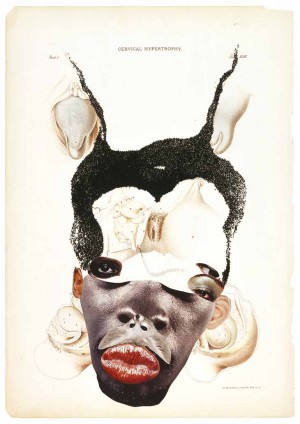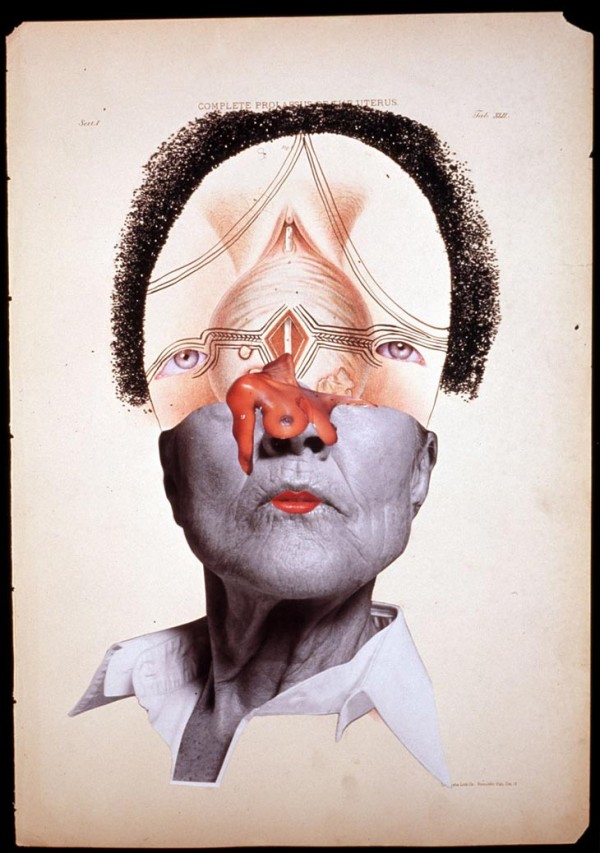Complete Prolapsus of the Uterus by Wangechi Mutu, 2004, Glitter, ink, collage on found medical illustration paper
You may not have heard of Kenyan-born artist Wangechi Mutu, but you will soon. In the fistful of years since her graduation from Yale’s MFA program, her work has shocked, angered, disfigured, and been applauded by curators across the United States. Dr. Joe Gregory, chair of Drexel’s Department of Art and Art History, saw a piece of hers in the MoMA a few years ago. He was instantly taken with her work.
Like so many gut-wrenching desires, Dr. Gregory’s went unrequited for years. Named “one of the most exciting artists working in collage today” by the New York Times, Mutu was busy responding to a deluge of requests for her work – from places like the New York’s MoMA and Whitney, the Museum of Contemporary Art in L.A. and a slew of galleries in Canada, the UK, and Germany, among other places. Philadelphia is moving up in the art world, but it couldn’t compete with that crowd – until now.
Sonia Sanchez, Philadelphia’s poet laureate, was so impressed by Mutu’s work that she committed to write a series of works if the burgeoning artist would agree to a Philly exhibition. That was enough to bring Mutu to the table, and now you can see an exhibition of her provocative, collage-as-cultural-critique at Drexel’s Leonard Pearlstein Gallery.
Mutu’s preferred modus operandi is to start with a picture, taken from just about anywhere – magazines, newspaper, encyclopedia, textbook, you name it – and then cut out pieces of the figure. She will then fill in the holes with other images. One piece  completed in this manner features a seductive woman relaxing on a white couch. The woman’s body has been cut out and replaced with the image of a child held by a tattooed hand. By carving out the locus of the woman’s sexual desire and replacing it with the image of unknown child, Mutu has produced a revealing X-ray of Madison Avenue’s objectification of female sexuality: We get aroused and buy things; she gets knocked up. The violence of Mutu’s scissored alterations changed my understanding of sex. Sure, I’ve been privy to similar messages before. We all have. But nothing has rearranged my guts before.
completed in this manner features a seductive woman relaxing on a white couch. The woman’s body has been cut out and replaced with the image of a child held by a tattooed hand. By carving out the locus of the woman’s sexual desire and replacing it with the image of unknown child, Mutu has produced a revealing X-ray of Madison Avenue’s objectification of female sexuality: We get aroused and buy things; she gets knocked up. The violence of Mutu’s scissored alterations changed my understanding of sex. Sure, I’ve been privy to similar messages before. We all have. But nothing has rearranged my guts before.
Equally provocative is a series entitled “Histology of the Different Classes of Uterine Tumors,” featuring a series of illustrations from Grey’s Anatomy depicting uteruses with various types of cancers that have been manipulated to resemble human faces. One of the most striking pieces in the series, “Fibroid Tumors,” replaces a woman’s nose with a knee, gigantic red lips underneath, and upside-down sunglasses above.
Her eyes are visible through the sunglasses and one is closed as though in the midst of a deep slumber while the other slightly open and almost in ecstasy, resembling one of those sex-sells cigarette ads featuring a Stepford wife lip-fucking a cigarette. Other faces in the series are equally iconographic but wide-ranging in emotional content. In fact, the whole exhibit whoops, laughs, commits murder, eviscerates, sighs, contemplates, and judges the media-saturated world where we are all prisoners of our own device. I will never be the same, and I like it.

